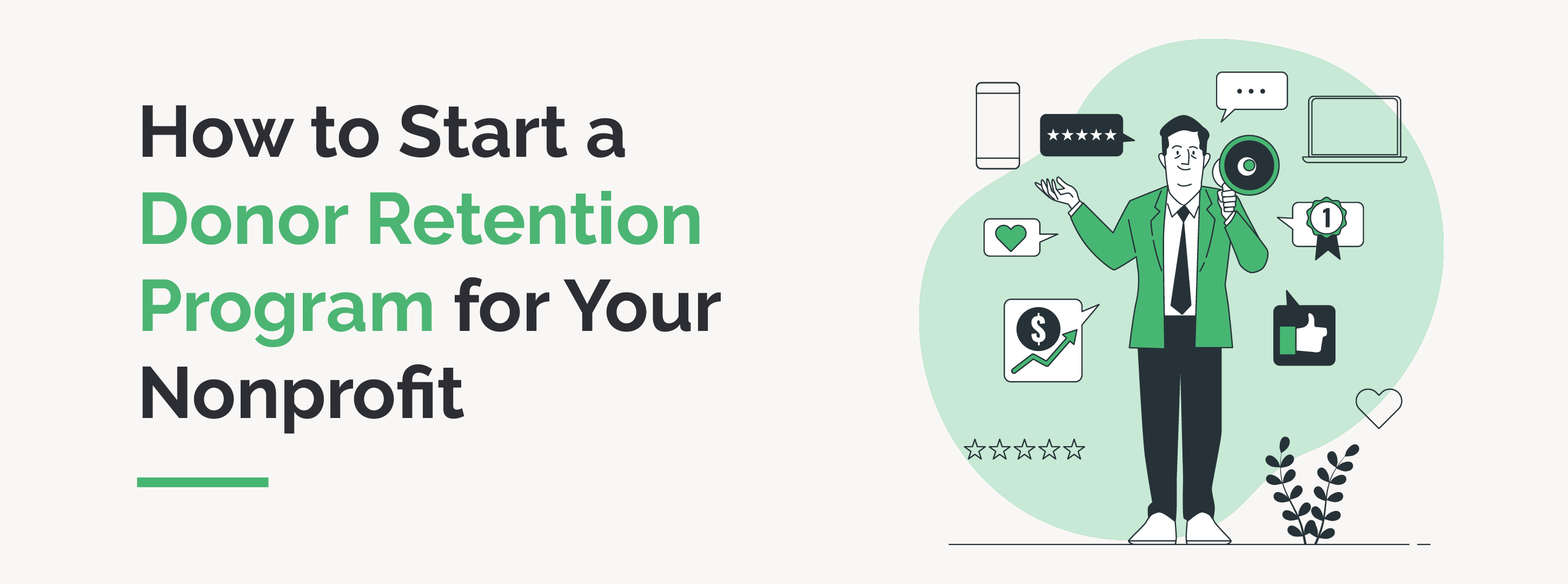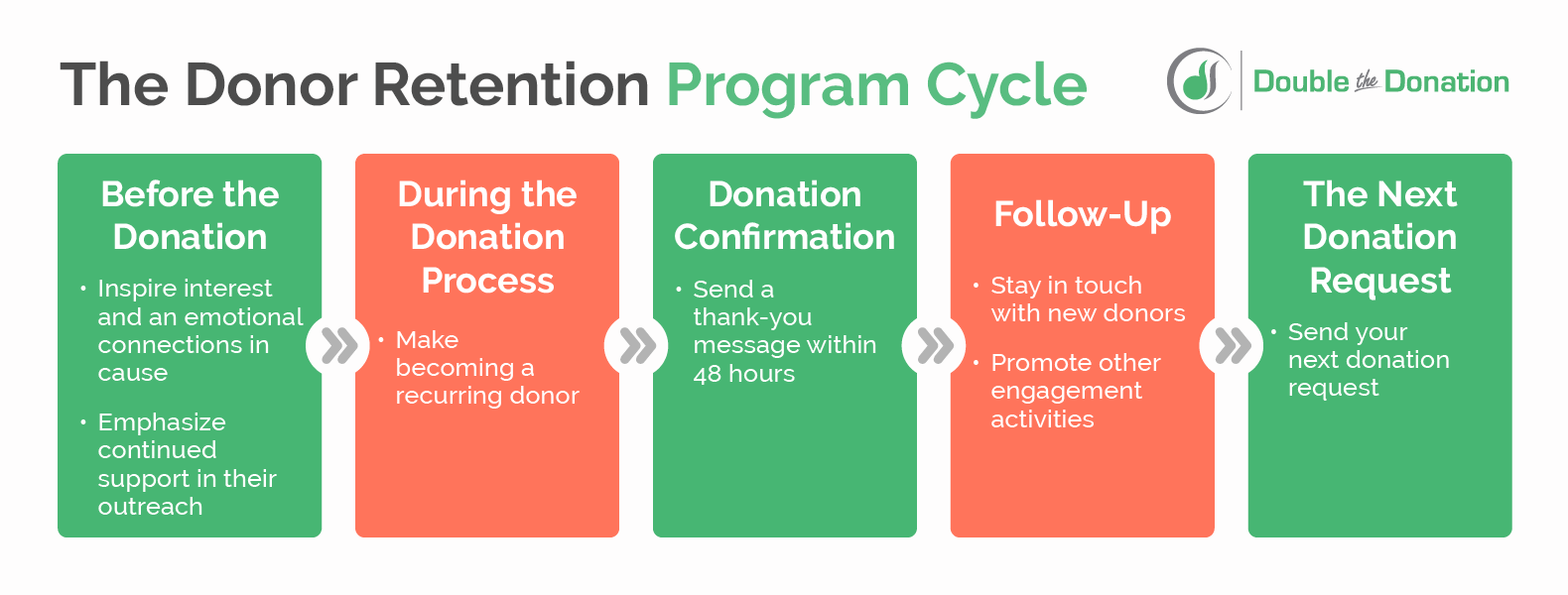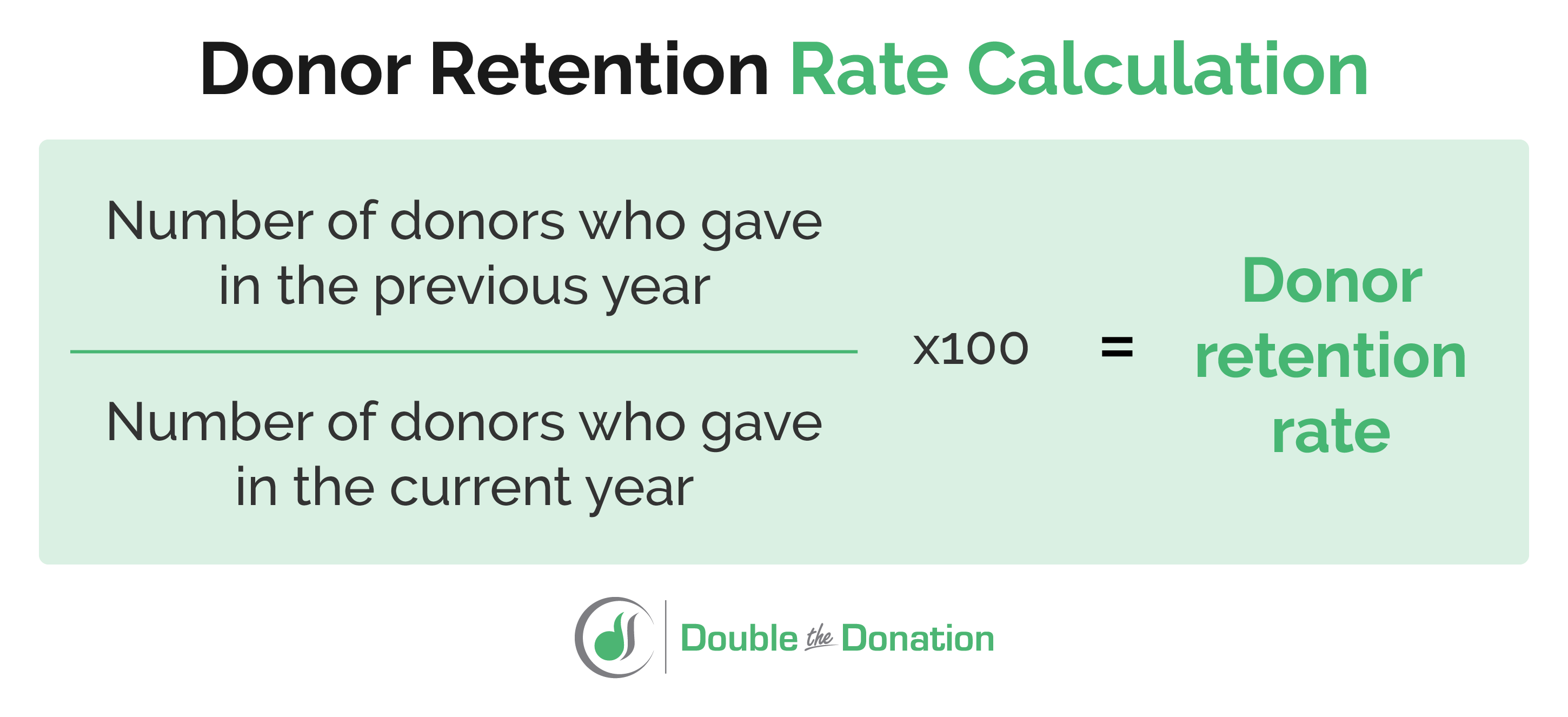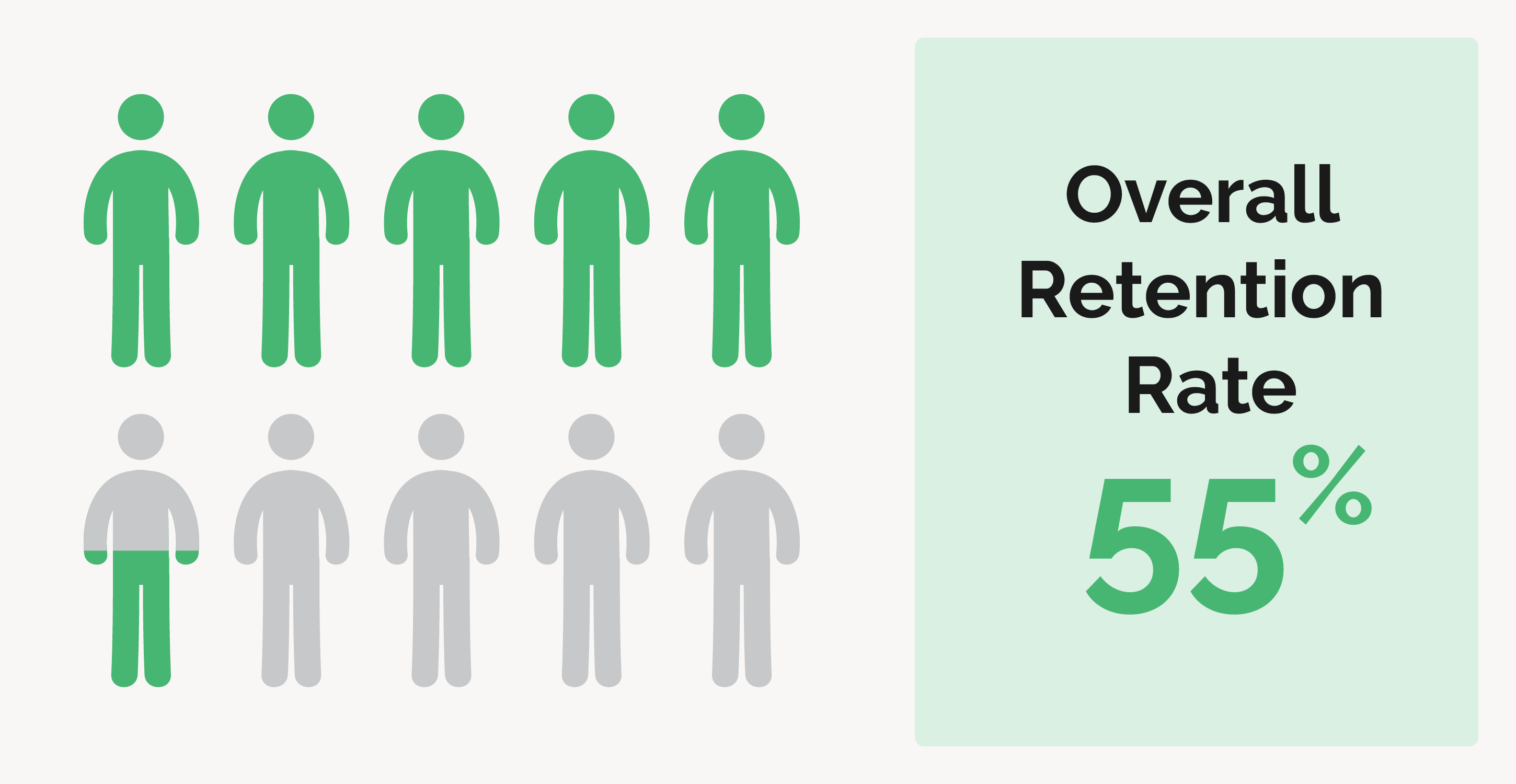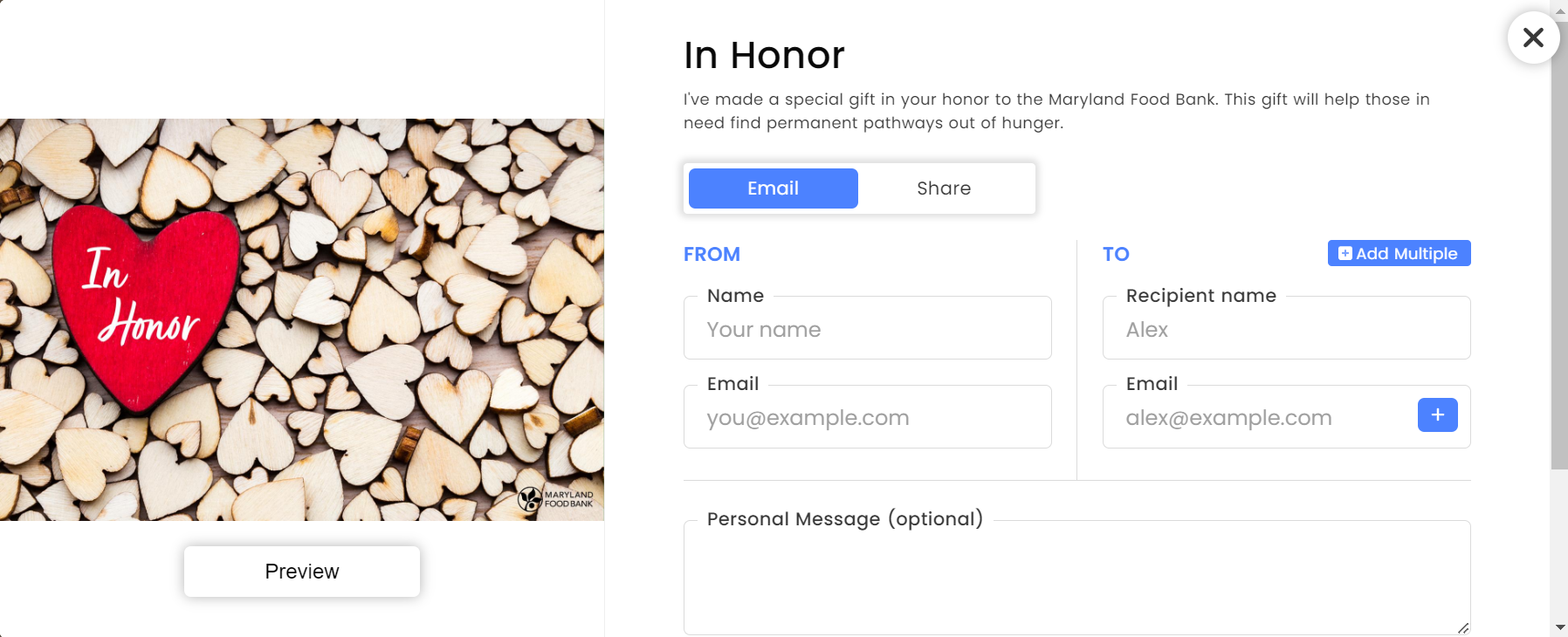How to Start A Donor Retention Program for Your Nonprofit
The importance of donor engagement is no mystery to nonprofit leaders. Engaged donors are loyal to your organization, meaning they’re more likely to support your nonprofit long-term. These supporters provide reliable revenue, attend events, and promote your cause to those around them.
For donors to form strong connections that inspire continued support, your nonprofit will need an effective donor retention program.
A structured donor retention program, backed by the right strategies and software, can keep your supporters coming back for years or even decades to come. In this guide, we’ll explore everything you need to know about standardizing your nonprofit’s donor retention practices:
- What are donor retention programs?
- What are the benefits of a donor retention program?
- How to calculate donor retention rate
- Tools for an effective donor retention program
- Donor retention program strategies
Returning donors are fundamental for a nonprofit’s success. However, nonprofits are likely to approach creating a donor retention program in numerous ways. Let’s start our deep dive into how to retain more donors by going over the fundamentals.
What are donor retention programs?
Donor retention refers to the rate at which a nonprofit’s donors continue to give after their first gift. Retained donors continue to give repeatedly over time and often participate in other activities the nonprofit offers, such as volunteering, attending events, or buying branded merchandise.
A donor retention program is the standardized process your organization follows for implementing donor retention strategies. Taking a wholly unique approach to relationship cultivation with each donor is not practical or even possible for most nonprofits. Donor retention programs provide set guidelines your nonprofit can follow for nearly every donor to encourage them to continue giving.
In order to engage first-time donors, donor retention programs should take into account their entire support journey. This timeline includes:
- Before the donation. During initial contact, nonprofits should aim to inspire interest and an emotional connection to their cause. To pivot potential first-time donors to recurring supporters smoothly, nonprofits should consider emphasizing the importance of continued support in their outreach.
- During the donation process. Many donors will decide whether they will offer recurring support while making a donation. Ensure the process is streamlined, and make becoming a recurring donor as easy as checking a box or pressing a button.
- Donation confirmation. Confirm to donors that you successfully processed their gift. Follow up your initial confirmation and donation receipt delivery with a thank-you message within 48 hours of when the gift was made.
- Follow-up. Stay in touch with new donors to stoke their interest in your nonprofit and encourage them to pursue other engagement opportunities. For example, you might invite them to subscribe to your newsletter, explore your website’s content, attend an event, or volunteer.
- The next donation request. For supporters who did not opt into recurring donations, plan to ask for a follow-up donation after a reasonable amount of time has passed since their last donation. For supporters who choose to become recurring donors, continue engaging them and thanking them for each gift.
Additionally, a donor retention program also takes lapsed donors into account. These donors used to give regularly but have recently stopped. The recapture rate for lapsed donors is only 4%, which means it’s often more effective for nonprofits to proactively focus on identifying donors at risk of lapsing and re-engaging them rather than waiting until they’ve stopped giving to take action.
What are the benefits of a donor retention program?
It’s easy to get caught up in the drive to attract new donors. After all, nonprofits need to continually grow their donor bases to scale their programs and better serve their beneficiaries. Acquiring new donors is also often a long and resource-intensive process, with it taking about eight touchpoints on average to earn a conversion.
With such high costs, nonprofits can maximize their resources by earning recurring support from as many donors as possible. For example, if you attract five new donors who only give once, you have to pay the costs for attracting them five times. However, if you attract one new donor who gives five times, you only spend the resources to earn those five donations once.
Along with being cost-effective, a donor retention program also systemizes your supporter engagement strategy. With processes in place for how to thank, communicate with, and re-engage donors, you can act more quickly, remove indecision paralysis, and grow your donor base.
How to calculate donor retention rate
You can calculate your donor retention rate by dividing the number of donors who gave in a previous year by the number of donors who gave in the present year. Then, multiply the quotient by 100 to get a percentage.
For example, let’s say 500 donors gave to your nonprofit last year and 275 of them gave again this year. 275 returning donors divided by 500 previous donors, multiplied by 100, would give you a 55% donor retention rate. This statistic means that more than half of last year’s donors stayed involved, beating the nonprofit sector average of 42.6%!
After calculating your retention rate, determine what that rate means for your organization and what rate you’d like to achieve. For example, you might make the following determinations about different retention rates:
- 0%-25%: Your nonprofit may have a lower rate in its early stages when cause and brand awareness are low. In this stage, share compelling calls to action that encourage active supporters to continue engaging with your nonprofit and focus on building relationships, such as by creating an email welcome series introducing them to your nonprofit. If you’re seeing rates like these, and your organization is not newly established, this should be a wake-up call that it’s time to make changes and reassess your donor outreach strategy.
- 25%-50%: If your donor retention rate falls in the 25-50% range, you’re likely about at or just below that nonprofit industry average. Pay close attention to your donors to spot signs that they may be at risk of lapsing and reach out before that can happen.
- 50%-75%: This range of retention is on the higher end, and your nonprofit should feel proud of its ability to forge strong connections with supporters. Keep hosting your engagement activities, showing your appreciation, and building a positive community that keeps supporters invested in your cause.
Keep in mind that donors give for all sorts of reasons, and attaining a 100% retention rate is virtually impossible. For instance, if you run a peer-to-peer campaign, your nonprofit will likely get a burst of support from new donors who give to your cause because of a personal connection to one of your fundraisers. Most of these new supporters will be one-time donors, but their support for that specific campaign is still valuable.
Tools to help retain donors
You wouldn’t start cooking before making sure you have all the ingredients, and the same is true about starting a donor retention program. Consider what tools you’ll need to reach out to and build connections with donors. We recommend exploring the following software solutions.
Auto-submission
What’s better than receiving regular gifts from a donor? Receiving regular gifts that are then doubled without your supporters having to spend a penny more!
Matching gifts are contributions corporations make to nonprofits that supplement their employees’ gifts, usually at a dollar-per-dollar ratio. For instance, if a donor regularly gives just $25 monthly but qualifies for a matching gift program, their employer will give an additional $25, totaling $50 each month. Over the course of a year, that donor and their employer will donate $600 to your nonprofit, all while barely impacting the donor’s budget.
However, the matching gift request process does require donors to take extra steps after making their initial contribution, which can result in them deciding that pursuing a match isn’t worth the effort, especially if they have to do it every time they give.
Fortunately, with Double the Donation’s matching gift auto-submission tool, your donors will have drastically less work to request a match. Auto-submission technology lets supporters jump from step two in the matching gift process all the way to step seven:
The normal process goes something like this:
- Donor makes a gift.
- Donor determines their matching gift eligibility.
- Donor searches for the necessary forms and guidelines.
- Donor fills out a matching gift request.
- Donor submits the request.
- The company assesses the donor’s match request.
- The company approves the donor’s matching gift application.
- Your nonprofit receives the matching gift funds.
With auto-submission, donors are done as soon as they determine their matching gift eligibility and agree to use auto-submission. From there, the tool completes the form for them and sends it off to their employer. Interested in learning a bit more about just how auto-submission technology accomplishes this? Here’s a breakdown of our revolutionary new tool:
To get started with matching gift auto-submission, your nonprofit will need matching gift software. Currently, Double the Donation is proud to be the only matching gift vendor that offers this cutting-edge feature. Qualifying supporters will also need to work for a company that uses CSR software that integrates with Double the Donation. This means not all of your recurring donors can take advantage of auto-submission, but those who can will have the easiest matching experience of their lives.
eCards
Picture this: you make two donations, one to nonprofit A and one to nonprofit B.
Nonprofit B sends you a confirmation email, but you don’t hear from them again until they send another donation request a month later.
Nonprofit A sends a personalized thank-you message shortly after your confirmation email. Then, they get in touch to give you an update on the program you donated to support. The following week, they let you know about an upcoming event in your area where you can meet other supporters in your community. Finally, they send a request for another donation.
Which nonprofit’s follow-up donation request are you more likely to answer? Most would say nonprofit A because they showed appreciation, helped the donor understand their impact, and made an effort to get them involved in their community rather than just jumping straight to asking for more money.
To be like nonprofit A, you need to follow the first essential step of showing your appreciation. There are numerous ways to recognize your donors, and one technology-driven strategy combines timeliness with memorability: eCards.
eCards are digital greeting cards that allow you to send eye-catching messages to donors through email, text, and even social media. Here’s a breakdown of how to use eCards in your retention strategy:
- Create branded eCards. Most eCard platforms will have basic templates you can use to start designing your cards, including image assets and fun fonts. To make your cards memorable, upload your brand images and any other graphic design elements you might want to include. Then, create a series of eCards you can send off to donors to thank them for their support, celebrate special occasions, invite them to events, or engage them in any other way you want.
- Determine when they’ll get sent out. You can set your eCards to get sent off automatically in response to a trigger, like a supporter donating, or you can choose to send out an entire batch of eCards at once. For instance, you might send all of your donors an eCard around the holiday season to remind them to get their gifts in before the end of the year.
- Continue sending cards. Don’t just send one eCard after a donor’s first gift! Continue designing and sending eCards throughout the year to keep your nonprofit fresh in your donors’ minds. You can even set up your donation process so supporters can send eCards to their friends and family after making a gift, spreading awareness of your nonprofit even further.
So just what does an eCard look like? eCards are fully customizable, which means they can look like just about anything! However, they’ll usually be a decorative postcard-like image next to a short but meaningful message. For example, consider this eCard created by the Maryland Food Bank:
Donor database
Most donor engagement strategies depend heavily on communication. Use the donor data you’ve gathered from your supporters’ past involvement with your organization to send personalized messages that make supporters feel remembered, recognized, and valued.
To target your outreach, you’ll need organized donor data. Invest in a donor database to track important donor information, such as:
- Contact information
- Preferred method of communication
- Giving and involvement history
- Participation in other organizations
- Employer information
- Payment method preference
Properly managed data is the key to collecting and using this information. If you’re missing data, consider conducting a data append to find missing or updated information, such as birthdays and mailing addresses. As you update information, look out for duplicate entries or irrelevant details that are cluttering your database.
Even if you only have a few details about your donors, you can encourage them to continue giving in specific ways. For example, with only a donor’s contact information and giving history, you might notice they only give at in-person events. Send an email inviting that donor to your next in-person fundraiser for a higher chance of retaining them.
Donor retention program strategies
Once you’ve set a target retention goal and acquired the tools you need, it’s time to develop your program’s strategies. The right approach depends on your unique community of supporters, but some time-tested strategies include:
Identify at-risk donors.
The best way to combat donor lapse is to catch them before they’re gone. To do that, you need to understand why donors stop giving. Gather data about your lapsed donors to analyze patterns in their behavior before they stopped giving by:
- Surveying lapsed donors. Most of your lapsed donors are gone, but a few of them might still be willing to answer a few questions about their decision. Ask straightforward questions, and be prepared for tough responses, such as not feeling appreciated, forgetting about your organization, or assuming your nonprofit doesn’t need their gifts anymore.
- Analyzing engagement data. For most of your lapsed donors, the signs were likely there. For instance, many lapsed donors will stop opening your emails or engaging with your content weeks or even months in advance before they finally cancel their donations.
- Considering external factors. Sometimes donors stop giving not because they no longer support your cause but because of outside factors. These can be as easily fixed as a recurring donor’s on-file credit card expiring or more troubling like supporters needing to tighten their budgets in times of economic downturn.
With this data, craft an at-risk donor strategy. For instance, if donors tend to drop during times of economic hardship, keep them engaged during the rough patch with non-giving related opportunities. Or, if a donor stops opening your emails, send them ones with subject lines that are likely to catch their attention by acknowledging the situation, like “It’s been a while since we’ve heard from you, [donor name]!”
Personalize communication.
Donors engage with nonprofits that offer activities that interest them. Of course, it’s unlikely that a single donor will want to engage with every activity your nonprofit has to offer. Personalize your outreach to share the opportunities that are the most relevant to each donor.
For instance, when promoting your planned giving program, younger donors and supporters new to your profit are unlikely to show much interest. Show your donors that you understand their individual preferences by tailoring the content you send to their interests.
You can better personalize your communication by dividing your donors into segments. Donor segments are groups of supporters who share relevant characteristics, and nonprofit CRMs often come equipped with segmentation features to simplify this process. For instance, you might divide your donors based on:
- Location
- Age
- Gift size
- Length of time giving to your organization
After determining your segments, create messaging strategies for each group. You can use email templates to help you get started, then use the information stored in your donor database to personalize each message even further by referencing donors’ names, past donation amounts, and engagement history.
Make opting into recurring donations easy.
The easiest way to retain supporters is to make giving automatic with a recurring donation program. Recurring donations are gifts donors make automatically, usually on a monthly basis. Since these gifts are deducted from donors’ bank accounts without needing any additional input from the supporter, they’re a simple set-it-and-forget-it method of donor retention.
Make joining your recurring donation program as easy as possible. You can do this by including a check box to make the gift recurring on your donation form. Or, offer suggested recurring donation amounts alongside higher suggested giving amounts for one-time donors to subtly push them toward becoming recurring supporters.
Recurring donations are lower than one-time donation amounts but add up over time. When donors see the low financial commitment of a recurring gift in comparison to higher one-time amounts, they may decide a recurring gift is the way to go.
Keep in mind that research shows that when offered a range of giving options, donors are most likely to choose the second lowest option. Additionally, always let donors enter a custom amount to give in case they want to give more or less than your suggested options.
Show your gratitude.
We’ve already discussed how you can use eCards to express your gratitude, but there’s even more you can do to show donors you care. For example, you could:
- Send letters in the mail. eCards are an amazing piece of technology, but traditional mail still has its place in many nonprofits’ donor appreciation strategies. Write personalized donor thank-you letters your supporters will want to hold onto and send out fundraising appeals at strategic times of the year, such as the week before Giving Tuesday to remind supporters to send in their gifts.
- Call donors. For donations above a certain amount, get on the phone, and give your donors a brief call. Write a script that volunteers can easily follow to knock out these calls, or go the extra mile and get your board members involved to make donors feel extra important.
- Send gifts. Celebrate the donors who have been with you for years by sending physical gifts in the mail. For example, on a donor’s birthday, you might mail them a t-shirt branded to your organization, or you might put together a welcome package to new donors who gave over a certain amount to persuade them to stick around.
These ideas are just the beginning, but if you need more inspiration for how to thank your donors, there’s an easy solution: ask them. Send out a survey asking donors how they want to be recognized so you can be sure you’re showing your thanks in a way they’ll appreciate.
Promote non-giving engagement opportunities.
As discussed in our earlier example of nonprofits A and B, if your only communication with supporters is strictly about donations, donations are likely to go down. Give your supporters more opportunities to get involved with your cause that don’t require spending, like:
- Volunteering. Invite your donors to take a more hands-on approach to supporting your mission by promoting volunteer opportunities. If your donors’ employers have a volunteer grant program, often called dollars-for-doers, they can fill out an application with their company and get their employer to donate to your nonprofit depending on how much they volunteered.
- Attending events. If a donor makes friends with other supporters in your community, they’re more likely to continue engaging with your nonprofit. The easiest way to introduce donors to the rest of your community is to invite them to events, whether they’re in-person or online, formal or casual, or meant for appreciation, fundraising, or spreading awareness.
- Exploring your content. Written a new blog post? Hosted a webinar or lecture about topics relevant to your cause? Or maybe you recorded a new video of your volunteers in action? Whatever your latest content is, let your supporters know about it. Giving them regular updates on your mission and inviting them to visit your website shows your community that your nonprofit is an active, dynamic organization that’s putting its donations to good use.
Not every donor will become a dedicated member of your community who wants to participate in extra opportunities. However, even for donors who are content to give quietly, seeing that your nonprofit does care about them beyond just cashing in their monthly gift is likely to make them think more highly of your nonprofit.
Conclusion and Additional Resources
After creating your retention program, keep testing and revising it as needed based on your donors’ changing needs. Track your donor retention rate to measure your progress, and get feedback from supporters to see how you can improve your program. Remember, donor retention is always ongoing, and the strategies that work today will need to adapt to keep up with your donor base five years from now.
For more information about revamping your strategy or expanding your audience, check out these additional resources:
- Prospect Research: The Ultimate Guide for Nonprofits. In order to retain or engage donors, you have to know who to reach out to. Read this guide to learn more about expanding your audience and targeting your communications.
- Donor Engagement: The Complete Guide + 9 Strategies. When donors enjoy their involvement in your organization, they’re more likely to stick around. Use the nine strategies in this guide to engage your donors more effectively.
- 15 Volunteer Statistics That Impact Your Nonprofit. Interested in engaging your supporters by offering volunteer opportunities? Stay up to date on the latest trends in volunteering with this statistical report.
